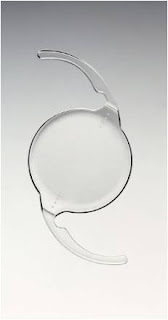Eye and visual problems are among the most commonly reported
problems among computer workers, affecting up to 70% of such a population in
some studies. The term Computer Vision Syndrome (CVS) refers to a range of eye
and vision problems related to near work during computer use. It is not a
specific disease, but rather, a range of symptoms related to visual demands
exceeding the ability of a person to comfortably perform the task. Although
associated with discomfort, there is generally no permanent harm to the eyes or vision.
Things that patients feel with computer use for prolonged
periods include
1) non-specific eye discomfort (often called eye-strain)
2) transient blurred distance vision
3) transient blurred near vision
4) dry or irritated eyes
5) headache, and even
6) temporary double vision.
1) non-specific eye discomfort (often called eye-strain)
2) transient blurred distance vision
3) transient blurred near vision
4) dry or irritated eyes
5) headache, and even
6) temporary double vision.
Why is there a
problem with computer work when there may be no problems reading other things?
Working at a computer requires frequent eye movements,
continuous eye focusing and alignment which involve repetitious muscular
activity. For example, frequent eye movements from paper documents to the
computer screen and back again occur. Viewing distances and angles for computer
work are often different from those commonly used for reading and other tasks,
with computer work often occurring at a distance slightly greater than the
normal reading distance.
Aspects of the computer display such as resolution, contrast
and glare also affect visual comfort. Often the letters on a video display
screen are not as sharp as those on a printed page. The presence of reflections
from the screen may also make viewing more difficult.
What factors may make
the problem worse?
Uncorrected long or short-sightedness, astigmatism and
‘old-sight’ can make working at the computer more difficult. ‘Old sight’ or
presbyopia refers to the natural loss of focusing ability (accommodation) with
age that tends to become manifest at about 40 years of age. Some of these
problems may not result in symptoms under less demanding conditions and some
patients are not even aware of their presence. Patients experiencing problems
should have a comprehensive eye test looking at the refractive power of their
eyes.
Other possible conditions include undetected latent squints
and dry eye. The prolonged concentration associated with computer work often
results in a reduced blink rate, which causes dry eye because of increased
evaporation of tears.
Children and
computers
Today, use of computers by children is increasingly common
both for education and play. Although children are more adaptable than adults
in many ways, they are not as self aware and may ignore problems otherwise
noticed by adults. For example, children may play an enjoyable game for hours
until exhaustion. As a result of prolonged eye effort, many of the problems
seen in adults may eventually be seen in children as well such as focusing
problems and even dry eyes. Of concern also is the possibility of prolonged
near work contributing to the progression of short-sightedness in children.
Children are also smaller than adults, and many computer
work stations may not fit them well. Awkward postures may result in arm, neck
or back discomfort.
When children use the computer, parents may want to
introduce strict limits on the amount of time they are continuously on the
computer. It is also a good idea to have the child’s vision checked some time
in early primary school to exclude any refractive error that can contribute to
eye strain. The work station should also be checked, with attention given to
raising the height of the seat so the child can work in a more comfortable
position.
Tips for managing and
avoiding computer vision syndrome
Owing to the fact that computer vision syndrome refers to a
range of complaints associated with computer use, its management is
multifaceted.
People who work on a video display terminal and easily feel
tired or uncomfortable should have a vision test to check for refractive
errors. Even if glasses are already being worn, they may not be the correct
power for the particular distance of the computer monitor. This is especially
important for the presbyopic patient. A computer is often placed at an
‘intermediate’ distance, in between a normal reading distance and the far
distance. For some presbyopes, glasses for intermediate distance in addition to
the normal bifocals may therefore be necessary. Occasionally a latent squint is
detected and if necessary the situation may be improved with special prism
glasses.
For comfortable use, the computer display should be suitably
positioned. Ideally, the top of the screen is placed just below the viewer’s
eye level, and tilted slightly upwards. This allows a comfortable view in
slight downgaze which may help with near focusing. Environmental lighting
issues are also important. When working on a computer, people should avoid
facing an unshaded window, because the much brighter background would make it
difficult to view the display screen. On the other hand, sitting with the back
to the window with bright light shining on the screen can cause reflections.
Use shades or curtains to control the amount of light entering the room.
Eye dryness often exacerbates the tired feeling many
patients experience. Apart from reduced blinking, the typical office is air
conditioned with very low humidity. Using artificial tears helps greatly, as
does the slightly lower computer screen since the upper eyelids are lower in
downgaze and the eye is less exposed to the environment.
Finally, it is a good idea to take short breaks from working
at the computer. During these breaks looking out a window or closing the eyes
for a few minutes rests the ciliary muscles of the eye responsible for
focusing. Blinking or closing the eyes replenishes the tear film. Fortunately,
despite the multitude of symptoms associated with computer use, relatively
simple steps can alleviate most of the problems and the problems are generally
temporary in nature.








.JPG)









